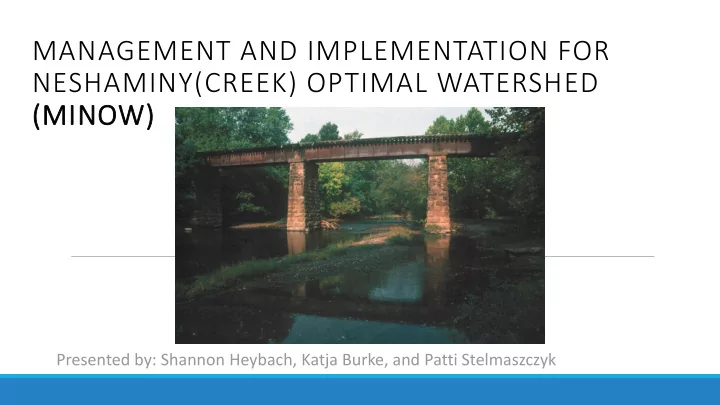

MANAGEMENT AND IMPLEMENTATION FOR NESHAMINY(CREEK) OPTIMAL WATERSHED (MINOW) Presented by: Shannon Heybach, Katja Burke, and Patti Stelmaszczyk
Overview ● Mission Statement ● Characteristics ● Land Use ● Water Use ● Existing Organizations ● Existing Regulations ● Proposed Solutions
Mission Statement To reduce Neshaminy Creek flow for a 2-year design storm by 10% before January 2020, thus improving water quality, preventing erosion, and preventing habitat loss.
Characteristics Length: 41 Miles Watershed Area: 233 square miles Population in 2000: 333,297 Projected Population in 2040: 368,000
Land Use ● The land use for Pennsylvania is mostly forested with regions of low and high intensity residential surrounding major city. ● The major land uses for the Neshaminy Creek watershed are agriculture, low density residential, and forest.
Water Use ● Most of the withdrawn water is taken from surface water. ● 78% of the water is withdrawn is used for Public Drinking Water ● 2nd highest uses are Mineral and Agricultural uses ● “Estimated” use includes unregistered withdrawals and other unmeasurable quantities such as evaporation.
Environmental Problems Problem Cause Result Flooding Increased Damage to infrastructure and a hazard Development to human health Streambank Erosion Flooding from Steep, unstable banks, increased increased sediments into creek, loss of habitat. runoff Loss of Habitat Streambank Decrease in diversity and total erosion, population of aquatic, and other creek urbanization wildlife. Increased Sediment, From increased large algal blooms and high levels of Nitrogen, and runoff and phytoplankton biomass which decreases Phosphorous erosion the dissolved oxygen concentration and concentration increases the toxic ammonia nitrogen
Existing Organizations North Branch Watershed Association: The NBWA works to improve the quality of the North Branch of the Neshaminy Creek through environmental education, promoting sound land use practices and conservation efforts. Bucks County Conservation District: A unit of the state government dedicated to the conservation of the soil, water and other natural resources in Bucks County, where the mouth of the Neshaminy is located. Water Resource Education Network: A project of the League of Women Voters of Pennsylvania dedicated to protect and improve water as a natural resource.
Existing Regulations NPDES Phase II: The National Pollution Discharge Elimination System Phase II stormwater plan and permit requirements for Municipal Separate Storm Sewer Systems will influence all municipalities in the Neshaminy Creek. If the municipality population is over a certain threshold population density, the municipality must be permitted under this program. River Conservation Plan: The River Conservation Plan is a critical tool in creating new partnerships within the watershed to promote inter-municipal cooperation and planning. The goal of this plan is to use it as a way to implement environmental change as if the groups were doing business. Act 167 Stormwater Management Plan: The Act 167 plan looks to reduce future stormwater impacts from new development, such as model ordinances and stormwater BMP information. Neshaminy Creek Watershed Work Plan Number 5: This work plan is to implement nonstructural alternatives opposed to flood control dams to provide the most protection from flood damage.
Proposed Solutions Problem Goal Solution Flooding Impervious surfaces G1: To minimize flood events and protect from property Riparian Buffers damage Individual Stormwater Management Programs Streambank Erosion Riparian Buffers G2: To minimize major erosion Stormwater Best management of stream banks practices Loss of Habitat Riparian Buffers-continuous G3: To secure floodplain land as greenway habitat for wildlife Increased Sediment, Nitrogen, Reduce runoff and erosion by G4: To ensure fishable and and phosphorous concentration riparian buffers and better drinkable water by improving stormwater management water quality in the Neshaminy Filtration of stormwater before Creek. it enters the natural system
Recommend
More recommend